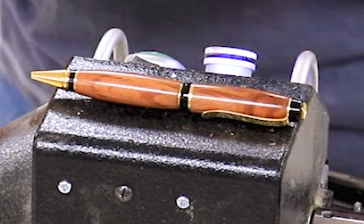Turning pens on your lathe is a blast, and offers some great advantages:
- It’s a relatively easy spindle turning project.
- Goes fast, so there’s instant gratification.
- It’s easy to sell nicely turned pens, so you can create some revenue for your shop.
- Pens make great gifts.
This article provides you with the basics of pen turning. Check out this video for comprehensive how-to on this topic.
What you need

You don’t need a huge lathe to turn pens. A midi lathe works fine for this project.

A mandrel is required to hold the pen parts on the lathe.

You’ll need a set of bushings to help you control the diameter of the turning blank. (They’re available from the same source as the mandrel.) The small diameter portion of the bushing goes inside the pen’s brass barrel. The outside diameter matches the pen kit. You need to double-check and match the bushings to the specific pen kit you’re using.

Carbide lathe chisels let you spend time turning, instead of sharpening. A set that include round, square and diamond-shaped tips will handle your pen needs.

A pen mill is HUGELY helpful in prepping the pen blanks. Use it in your drill press to finesse the ends of the blanks before turning.

Pen kits are available from a variety of sources including Penn State Industries, Rockler and Woodcraft. Be sure to match the pen kit with the bushings.
Prep the blanks

Directions that come with the kit will tell you how big the blank should be, and what size hole you need to drill for the kit’s brass barrel.

Drill the hole for the brass barrel at your drill press. Trigger clamps work great for securing the small wooden blanks.

Use medium CA (cyanoacrylate) glue to glue the barrels into the wood blank.

Rough up the barrel with 120-grit sandpaper, and glue it into the blank.

Use the pen mill to remove any glue from the inside of the barrel and flush the barrel with the end grain of the blank.
Turn the blanks

Mount the mandrel on your lathe and the blanks on the mandrel.

Turn the wooden blanks round…..

…and then shape the ends of the blank to the outside diameter of the bushings. Leave the wooden blank a little oversize. It’s easy to sand it to its final diameter. Use different shape lathe chisels to introduce different shapes to the pen.

Sand the pen on the lathe, working from 150-grit to 220-grit or higher.

Apply finish while the blank is still on the lathe. This makes it very easy to polish the wood to a nice gloss.
Assemble the pen

Read the directions for your kit. There are often very distinct ways for the pen to go together. A trigger clamp works well for squeezing the components closed.

Enjoy your pen!!




